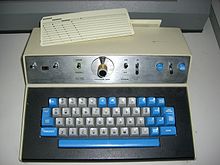Punch card punch

Punch card punch and punch card punch , English Key Punch or Card Punch , were used to create punch cards .
Punch cards were used
- for controlling machines as carriers of the program code or
- As a storage medium for data sets in data processing - often for input data , but also for storing master data, address data, etc.
Punch pliers
On September 23, 1884, Herman Hollerith filed his first patent application on the subject of "Art of Compiling Statistics". In the following years he experimented with different punch card formats and arrangements. In 1886 cards were used in Baltimore that "... had three rows of holes on each of the two long sides with a total of 192 hole positions". The punch was punched with a punch .
Mechanical punch

- In Hollerith's pantograph punch , which he presented for the census in 1890 , the pantograph was used to transfer the sources of the counting results to the punch card .
- Independent of this, later, primarily used as an auxiliary device, “hand punch” with a slide for the punch card and a mechanical punching unit for creating or correcting individual punch cards were used.
The initially purely symbolic coding came up against limits over the course of time. B. the tabulating machine required numeric , later alphanumeric coding of the punch card. That delivered the
to 1. pantograph punch not that
to 2. depending on the specimen (reflecting the then current state of the art) but was clearly inefficient.
Electromechanical punches
The punches were "electromechanized" in the course of technological development.
This essentially means two devices with a different range of uses.
Punch card punch
To operate the device, data typists were often used - in the field of data acquisition - who created the punch cards “in stacks” from the documents or templates they had. The cards created could be verified with the help of the punch card tester. The data throughput was low, up to 10 characters / s.
Punch card punches were sometimes also called "punch card punches"; not to be confused with the device described below.
The first electromechanical punch comes from IBM in 1923 with the type designation IBM 011. From 1964 (IBM 029 see picture) programmable punches (using a punch card on drum, see picture) are documented. This control aid made it easier, for example, to jump to tabs, so that only partial areas of the card could be punched (e.g. additional).
Programmable punches were still in use until the mid-1980s. Punched card punches were also used in the work preparation of data centers (for the creation of JCL control cards ) as well as by programmers who used them to create punched cards that contained the source code of programs .
Punch card punch
This was used for the automatic creation of punch cards and - in contrast to the punch card punch - controlled by an upstream machine. As a peripheral device , it was initially used by the tabulating machine and later by the computer as an output device. Some models had a toroidal core memory , thus buffering the data and thereby relieving the processing unit. If necessary, the punched cards could be checked for correct perforation with a downstream reading station. The throughput was 100 to 400 cards / minute.
literature
- Sebastian Dworatschek: Introduction to data processing. 5th edition. de Gruyter, Berlin et al. 1973, ISBN 3-11-004280-0 , p. 274.
Manual (English, PDF)
Keypunching
- IBM: IBM Reference Manual: IBM 29 Card Punch June, 1969, A24-0520-2.
Individual evidence
- ↑ The History of Machine Data Processing, Volume 1: IBM Encyclopedia of Information Processing, IBM Form D 12-0028 (3/91), page 18
Web links
- Columbia University Computing History: IBM Keypunches , there specifically:
- Heinz Nixdorf Museumsforum shows Hollerith machine , by Detlef Borchers on May 10, 2007 on Heise online



